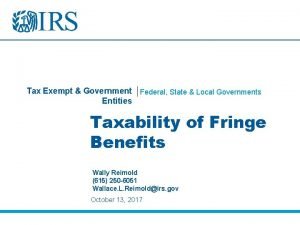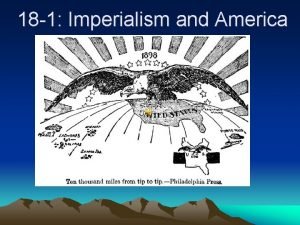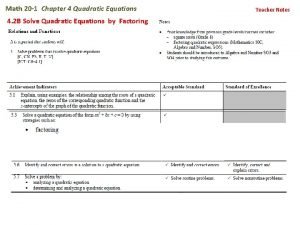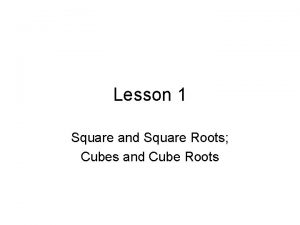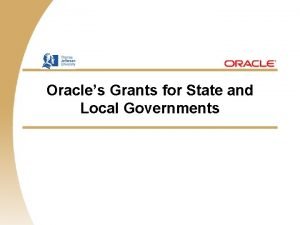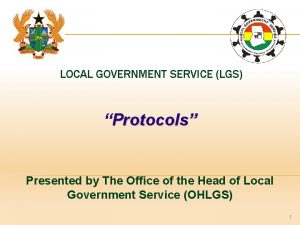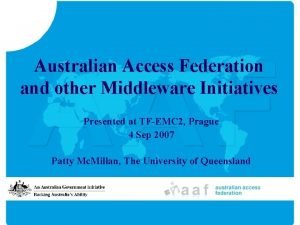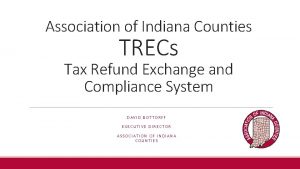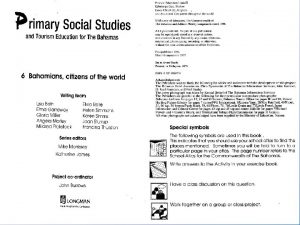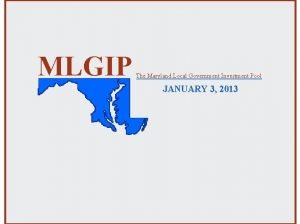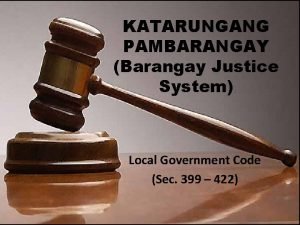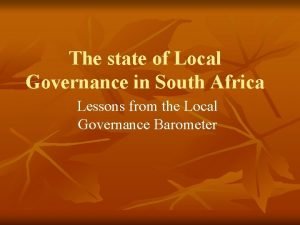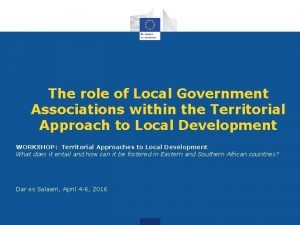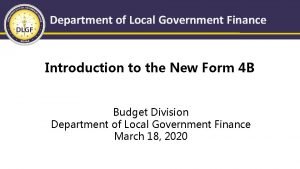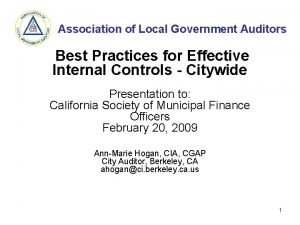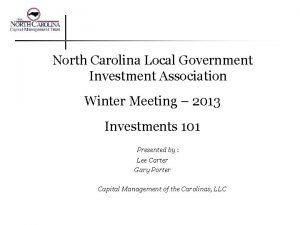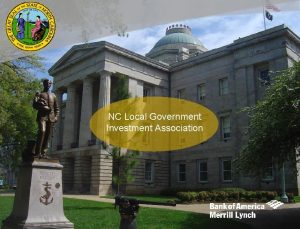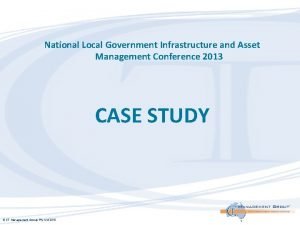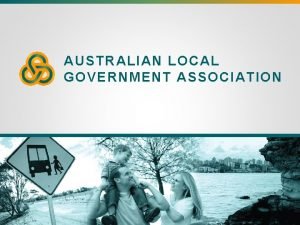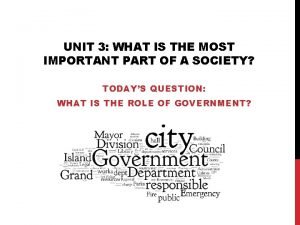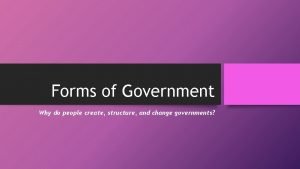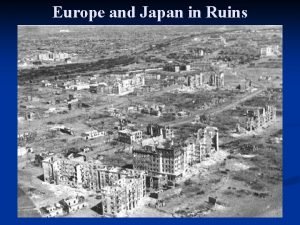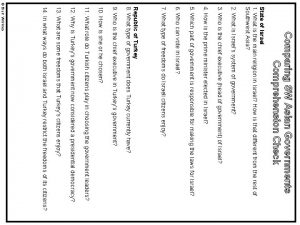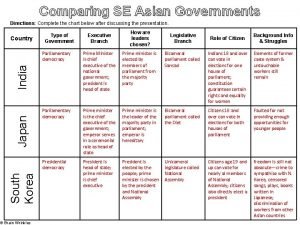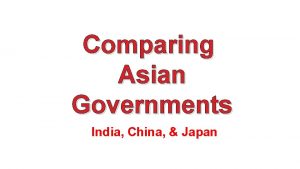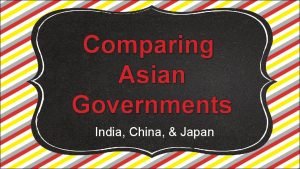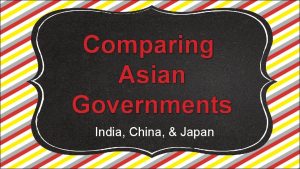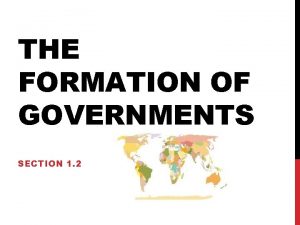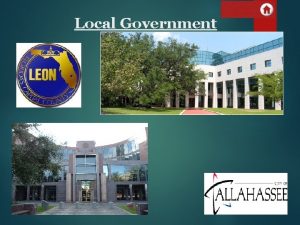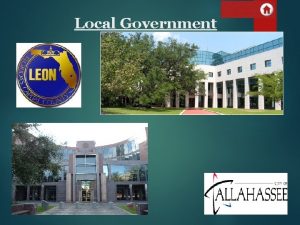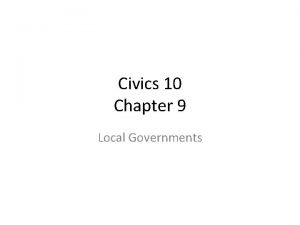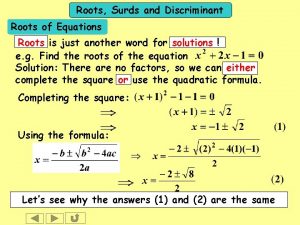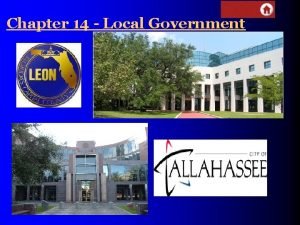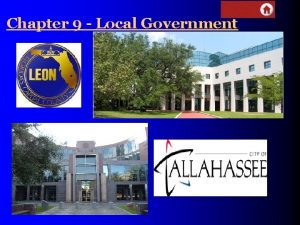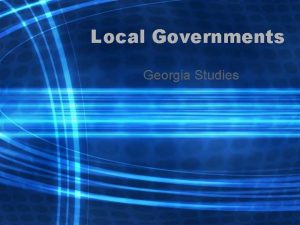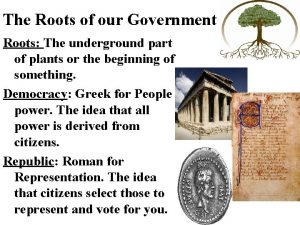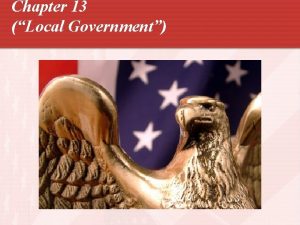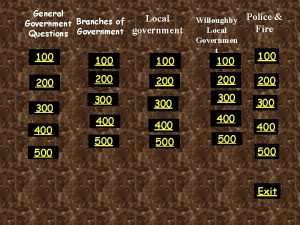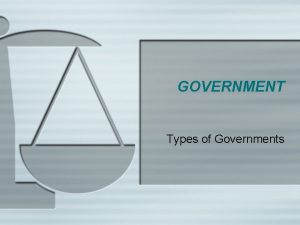Local Governments Chapter 7 Roots of Local Government







































- Slides: 39

Local Governments Chapter 7

Roots of Local Government n n n Municipalities and Counties created when Texas was a part of Spain and Mexico. Under the Republic, counties (36) and municipalities (53) were created. After 1845, additional counties were created. 1876 Constitution continued county governments, adding more offices and number of counties until 1931, when Loving County became the 254 th county. Home rule for Texas cities came with a constitutional amendment in 1912.

Counties n Administrative units of the state q q n Collect taxes Keep records Conduct trials Conduct elections General purpose government q q q Provide public safety Public works Parks, libraries, etc.

Government Structure n Commissioners Court q q q n County Judge q q n County judge and 4 commissioners Adopts the budget and sets the tax rate Legislative body for county Presides over commissioners court Performs executive functions Sheriff q q Law enforcement County Jail

Government Structure n Tax Assessor-Collector q q n County clerk q q n Collects taxes Automobile registration Records of the county: births, deaths, marriages, divorces, transfers of property Elections District clerk q records of state district courts

Government Structure n County Treasurer q q n County’s banker and pays bills Records of revenues and expenditures County Auditor q q q Counties with population greater than 35, 000 Same functions as treasurer Chief budget officer and finance officer Audits county financial records Approves accounting system Checks monetary claims against county

County Finances: Taxing and Spending n Revenues q q n Property tax Sales tax Bonds: general obligation and revenue Fees: automobile registration Expenditures q q q Law enforcement Roads and bridges Services: parks, libraries, etc.

Criticisms of County Government n n n Structure inflexible Plural executive inefficient No home-rule authority Patronage hiring Roads and bridges responsibility of county commissioner in his/her precinct

Types of Cities n General law cities q q Operates under the state’s general laws: can only do what the state allows Fewer than 5, 000 residents Property tax rate limited to $1. 50/$100 assessed valuation Sunset Valley

Types of cities n Home-rule city q q Creates its own charter: can do anything unless prohibited by the state More than 5, 000 residents Property tax limited to $2. 50/$100 assessed valuation Austin

Forms of City Government n Mayor-Council q q n Strong Mayor-Council q n Most common for general law cities Mayor is chief executive; council is the law-making body Mayor is sole executive authority Weak Mayor-Council q Mayor shares executive powers

Mayor Council Government (strong)

Mayor Council Government (weak)

Forms of City Government n Council-Manager q q q Most common in home-rule cities Council is the law-making body Mayor is member of Council but has no executive authority Manager is the executive authority; hired by the council; hires and fires department heads; prepares budget Reform during the Progressive Movement

Council Manager Government

Forms of City Government n Commission q q q Council is the law-making body Mayor is member of Council but has no executive authority Each council member has authority over a specific function of city government, e. g. police department, fire department, etc. Originated in Galveston, Texas after the hurricane of 1900 destroyed the city. No examples in Texas presently

Forms of City Government n Citizen Advisory Boards q q n Planning and Zoning Commissions q n Advise council in various areas Temporary or permanent Recommendations on changes to zoning and subdivisions ordinances and exceptions to subdivision ordinance Boards of Adjustment q Grant exceptions (variations) to the zoning ordinance

Types of Council Elections n At-large elections q n Voters cast number of votes equal to number of council members being elected. Top vote getters win council seats At-large-by-place elections q Council divided into numerically designated places. Candidates file for a place. Voters choose candidates in all places being contested. Majority of votes necessary to win. Runoff if no candidate receives a majority.

Types of Council Elections n Single-member districts (wards) q q n City is divided into geographic zones that are equal in population, compact, and do not dilute minority voting strength. Voters choose only council member in their geographic zone. Mixed system q Some council members elected at-large, and other council members elected from single-member districts.

Austin Single-member Districts

Austin Single-member Districts

Austin Single-member Districts

Advantages and Disadvantages of Methods of Election n At-large elections q q q n Council members act in interest of city as a whole Minorities may not be represented fairly Works well in small, homogeneous cities Single-member and mixed systems q q q Council members have more parochial outlook Minorities more likely to be fairly represented Works in large, heterogeneous cities

Alternative Election Systems n Proportional Representation q n Council elected based on proportion of vote for political parties Cumulative Voting q q Like at-large systems EXCEPT voters can allocate their votes as they wish. For example, if four council seats were being contested, each voter would get four votes. A voter could distribute the four votes as s/he wished: all four to one candidate, three to one candidate and one to another candidate, etc.

City Ordinances n n Laws passed by city to provide services and regulate activities in the city’s corporate limits Most important are zoning and subdivision ordinances q q Zoning ordinances involve height restrictions, use restrictions, and density restrictions. Subdivision ordinances provide restrictions for an entire area

Growth of Cities n Annexation q q Process by which city increases its size Typically, a city annexes for several reasons: provide services, increase tax base, extend its regulations City council usually makes the decision on whether to annex an area Area annexed is usually an unincorporated area

Growth of Cities n Limits on annexation q q q Annex up to 10 percent of its area per year with maximum of 30 percent in any one year. Annexation plan (100+ tracts residential) three years prior to annexation. Annexation occurs within 31 days of the 3 -year anniversary. If not, must wait five years. Annexed area contiguous to current city limits. Municipal services within 2 ½ years Land use grandfathered Strip annexation: 1000 feet swath 3. 5 miles long

Growth of Cities n Limits on annexation (continued) q q q Make an inventory of the current services in the area. Provide to the annexed area all services currently provided in its full-purpose boundaries no later than two and one-half years after annexation. Require negotiations and arbitration regarding services. Conduct at least two public hearings. Not reduce level of services in the area from what they were before annexation.

Extraterritorial Jurisdiction n n Area immediately surrounding a city Extent of ETJ determined by the city’s population: ½ mile to 5 miles Area within a city’s ETJ cannot incorporate without the city’s consent Some regulations possible in a city’s ETJ, but not zoning ordinances

Municipal Finances: Taxes and Spending n Revenues q q q n Property tax Sales tax Issues bonds: general obligation or revenue Expenditures q q q Police and fire protection Public works: water, wastewater, streets, signs, traffic control Parks, libraries, health facilities, etc.

Join the Debate: Red-Light Cameras n Arguments for Red-light Cameras q q q n Reduction in traffic fatalities Law enforcement can focus on real problems Constitutional method of traffic code enforcement Arguments against Red-light Cameras q q q Violate constitutional rights Generate money but don’t improve safety Other methods are more efficient

Special Districts n n Single purpose government Formed by state legislature, state boards or commissions, constitutional amendments, county commissioners court, city councils Formed because general purpose governments can’t or won’t act Funded by tax and fees

Types of Special Districts n Educations districts q q n n Independent School Districts (ISDs) Community College Districts Water Districts Municipal Utility Districts (MUDs) Hospital Districts Rapid Transit Authorities

Types of Special Districts Type of District Water & Wastewater Econ & Com Dev Health & Safety Agriculture Transportation ISDs Community Colleges Total # Active 1373 96 480 0 29 1227 50 3255

Problems with Special Districts n Ease of creation q q q n Developers create MUD issue bonds Homeowners pay through cost of home or property tax and through fees for services Obscurity to Public q q People may not realize they’re in a special district Districts operate with little regulation

Alternatives to Special Districts n Metrogovernments q q q n Regional government combining county and city services Offers economy of scale Problems of eliminating positions and how to integrate local governments Intergovernmental contracting q Government contracting with another government to provide service

Alternatives to Special Districts n Privatization q q Turning over government functions to private companies Controversial issue – police protection to security firms, deed restrictions in subdivisions, homeowners associations

Councils of Government n n Planning and Coordinating organizations for other governments No authority over members – similar to a confederation 24 COGs in Texas Provide technical and managerial assistance, process applications for federal grants, and run state and federal programs for the region

Local Governments and Democracy n n Many opportunities for citizen participation Low voter turnout in local elections Ignorance of local government, especially special districts Local governments affect people’s lives directly
 Are local governments tax exempt
Are local governments tax exempt Vanessa jason www.biology-roots.com
Vanessa jason www.biology-roots.com Perfect square definition
Perfect square definition Lesson 3 existence and uniqueness
Lesson 3 existence and uniqueness Economic roots of american imperialism
Economic roots of american imperialism Product of roots of quadratic equation
Product of roots of quadratic equation All the perfect squares
All the perfect squares State and federal constitutions
State and federal constitutions Local government service appraisal form
Local government service appraisal form Oracle grants management
Oracle grants management Local government protocols
Local government protocols Australian access federation
Australian access federation Trecs local gov. clearinghouse
Trecs local gov. clearinghouse Commonwealth local government forum
Commonwealth local government forum Commissioner of local government
Commissioner of local government Local government investment pool services louisiana
Local government investment pool services louisiana Barangay justice system tagalog
Barangay justice system tagalog State of local government barometer
State of local government barometer Classification of local government
Classification of local government Local government finance
Local government finance Department of local government finance
Department of local government finance Association of local government auditors
Association of local government auditors Local government investment pool services north carolilna
Local government investment pool services north carolilna Local government investment pool services north carolilna
Local government investment pool services north carolilna Local government asset management software
Local government asset management software Definition of local government
Definition of local government Georgia state government
Georgia state government Mav local government
Mav local government Australian local government association
Australian local government association Different kind of governments
Different kind of governments Why do people create, structure, and change government?
Why do people create, structure, and change government? Note three ways u.s. occupation changed japan.
Note three ways u.s. occupation changed japan. Comparing sw asian governments comprehension check
Comparing sw asian governments comprehension check Comparing sw asian governments answer key
Comparing sw asian governments answer key Comparing asian governments
Comparing asian governments Comparing asian governments
Comparing asian governments Comparing asian governments
Comparing asian governments Centre region council of governments
Centre region council of governments Comparing african governments
Comparing african governments The formation of governments 1-2
The formation of governments 1-2
